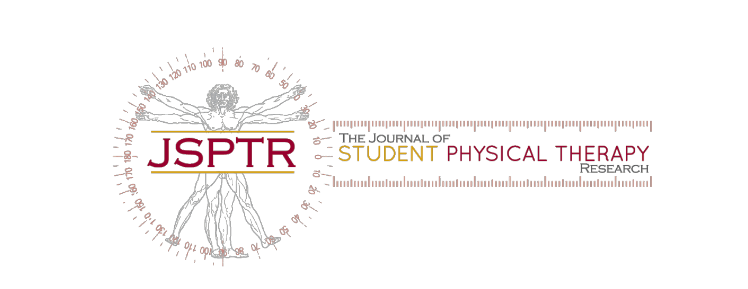Volume 5:2
The Use of Virtual Reality to Improve Gait Function in Stroke Patients
Andrea Cortese, SPT; Katie Horr, SPT; Erin Krautle, SPT; Jacquelyn Liebig, SPT; Neal Scibelli, SPT; Martha Sliwinski, MS, PT, PhD
Columbia University Medical Center, Department of Physical Therapy – New York, NY
Study Design: This study is a literature review of five major scientific databases. Articles were evaluated using the Oxford Center for Evidence Based Medicine, the scale ranges from 1a to 5. A 1b or higher level of evidence was the criteria for inclusion in this review.
Objectives: By reviewing the current literature, this study aimed to determine the effects of Virtual Reality (VR) training on gait parameters in patients recovering from a stroke.
Background: There are 800,000 incidents of stroke each year in the United States. Associated with the high incidence is a large cost of rehabilitation, both in dollars and in time required from Physical Therapists and other medical staff. There is a need for efficient and effective therapies that will reduce the cost of care for these individuals. VR has been used as a therapeutic tool because it provides a safe and engaging method to retrain motor impairments and the rehabilitation of gait patterns. VR has been proposed as an effective and engaging treatment method for patients post stroke.
Methods and Measures: A search was conducted of five major databases (Cochrane Library, Google Scholar, Ovid, PubMed, and Scopus) using the search terms „gait,‟ „stroke,‟ and „virtual reality.‟ Four studies met the inclusion criteria, and were included in the literature review.
Results: The results of the analysis showed that significant improvements in gait parameters occurred with the addition of VR training to a standard physical therapy protocol in individuals with a stroke. The effect size in all significant outcome measures was moderate to large (ES >.50).
Conclusion: The addition of VR to a conventional physical therapy plan of treatment for individuals who have suffered a stroke may facilitate significant improvements in gait parameters as compared to a standard physical therapy treatment plan. Further controlled research assessing the effect of VR interventions and the outcome on gait in individuals with a stroke is necessary to improve the validation of VR for gait training purposes in this population, due to small sample sizes and inconsistency in outcome measures between studies.
Development of the Screen for Limitations in Mobility (SLIM): A Self-Report Tool for Surgical Oncology Patients
R Spencer; T Fee; E Hall; A Rogers; M Sluzar; D Law; E Weitzner; V Wheeler; NM Salbach; N Cooper
University of Toronto
Sunnybrook Health Sciences Centre, Toronto, Ontario, Canada
Study design: Multi-step development of a self-report screening tool including quantitative analysis of face validity, content validity, and comprehensibility.
Objectives: To develop a self-report screening tool to identify surgical oncology patients requiring a referral to physical therapy to address functional mobility limitations, and to evaluate face validity, content validity and comprehensibility of the tool.
Background: Health care professionals do not consistently identify the limitations in functional mobility experienced by patients after surgical treatment of abdominal and gynecological cancer. As a result, appropriate referrals to rehabilitation may not occur.
Methods andMeasures: A multi-step, quantitative study was conducted involving initial development of the tool, evaluation of its face and content validity by ten physical therapists with experience in surgical oncology, and evaluation of its comprehensibility by seven post-surgical oncology patients.
Results: The tool was judged to have both face and content validity based on feedback from ten physical therapist participants and a review by the research team. Comprehensibility of the tool, including items and instructions, was confirmed by seven patient-participants. The tool, named the Screen for Limitations In Mobility (SLIM), includes thirteen items with two possible response options for each.
Conclusions: The SLIM may assist in identifying functional mobility limitations in surgical oncology patients with abdominal and reproductive cancer and facilitate appropriate referral to physical therapy to address these limitations. Future studies are necessary to determine reliability of the SLIM in specific oncology populations.
A Theraband™ Simulation of the Penguin Flight Suit on Stability Measures in Healthy Older Adults
Simon K. Ho, SPT; Stephen P. Lahr, PT, PhD; and Terri Hoppenrath, PT, MS, DPT, GCS
Ithaca College – School of Health Science and Human Performance, Department of Physical Therapy, Ithaca, NY
Study Design: Quasi-experimental pretest-posttest design. Objective: The purpose of this study was to compare the effects of the penguin flight suit and a simulation of it constructed with Theraband™ straps on various tests of balance and stability.
Background: The penguin flight suit was originally developed and used by the Russian Space Agency for maintaining muscle and bone mass in a reduced-gravity environment by employing compressive forces on joints. Early studies on the flight suit as a treatment modality in children with cerebral palsy have been shown to have some improvements in balance. Thus, a simulation of the flight suit constructed with Theraband™ straps that recreate these compressive forces could lead to a cost-efficient clinical tool for a population known to have impaired balance.
Methods and Measures: Fifteen healthy older adults aged 60-95 were recruited as a sample of convenience. Using the NeuroCom Balance Master®, data was collected under four consecutive conditions: first without any external compression, followed by the flight suit and straps in randomized order, and finally without either form of compression following a five-ten minute “rest” period after the suit or straps were removed. Measurements of Limits of Stability (LOS) and Rhythmic Weight Shift (RWS) were used as outcome measures to assess changes in balance and stability.
Results: Composite data was analyzed using a one-way ANOVA with repeated measures. Statistical analysis of the LOS test showed a significant difference between the control and the final measure in the end-point and max excursion measurements. No significant differences were seen between the control, flight suit, straps or final measure in the directional control measurement of the LOS test. Statistical analysis of the RWS tests also showed no significant difference between any of the four test conditions.
Conclusion: Although a significant difference between the control and final measure was found in the end-point and max excursion measurements of the LOS tests, we concluded that overall neither intervention produced immediate improvements in measurements of balance and stability in this study. Further research with stronger designs is required to determine the clinical utility, if any, of these two interventions.
Measures of Cardiovascular Health and Physical Function improve after an Aerobic Exercise Intervention in a Patient Fifteen Days Post-Stroke
Angela A. Lentz, DPT; Anna E. Mattlage, MS; Abigail L. Ashenden, SPT; Michael A. Rippee, MD; Sandra A. Billinger, PT, PhD
Study Design: Changes in cardiorespiratory (CR) fitness post-stroke severely impact an individual’s quality of life. The purpose of this case study was to demonstrate whether a moderate to high intensity aerobic exercise program would improve cardiovascular fitness and physical performance measures in a participant following discharge from acute stroke rehabilitation. The participant is a 58-year-old female who experienced an ischemic stroke fifteen days prior to beginning the exercise intervention.
Case Description: The participant was provided a supervised eight-week exercise intervention on a Total Body Recumbent Stepper (TBRS). The exercise intervention consisted of three sessions per week; the first four weeks the participant exercised at a moderate intensity of 50-59% heart rate reserve (HRR) calculated from the baseline exercise test; the last four weeks the intensity was increased to 60-69% HRR. Exercise duration began at twenty minutes with the goal of reaching thirty minutes of continuous exercise at a specified workload.
Outcomes: Following eight weeks of intervention, the participant showed improvement in cardiovascular measures including: resting blood pressure (BP), resting heart rate (HR), VO2 peak, and the maximum distance walked (6-MWT).
Conclusion: The use of a moderate to high intensity aerobic exercise intervention may be effective for participants in the sub-acute phase of stroke recovery in order to improve cardiovascular health and physical function.


